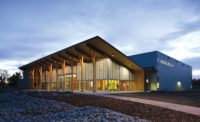
Over the next three years, builders and contractors will witness an unprecedented rise in energy-efficient construction. Energy efficiency advocates succeeded in tightening the 2009 and 2012 International Energy Conservation Code with an estimated 30 percent improvement between the 2006 and 2012 versions of the code. The popular Energy Star program for new homes will institute more rigorous standards in January 2012, and the major green building rating systems including LEED, LEED for Homes and the National Green Building Standard plan to unveil new versions.
As the construction industry migrates towards more energy-efficient building enclosures, “alternative” building systems like structural insulated panels are emerging as a popular option to simplify the construction process and keep cost increases to a minimum. SIPs are certainly not a new technology (they have long been recognized for their insulating and air sealing abilities) but in the new era of energy efficiency, more and more builders are realizing the time and cost saving benefits of framing, insulating and air sealing a building in a single step.

David Peabody’s Passive House will require one-tenth of the energy used to heat and cool a typical home. The 68,000 square-foot Jacob E. Manch Elementary School (next picture) in Las Vegas uses half the energy of the district’s standard school design.
The Path to a High Performance Building Envelope
There are many ways to save energy, from using efficient HVAC equipment to low U value windows, LED lighting, just to name a few. The challenge for today’s building designers is achieving the maximum efficiency for the lowest cost.Although high tech systems often get more press coverage, the new IECC, Energy Star and other voluntary programs reflect the industry consensus that improving the building envelope is the most cost-effective way to cut energy use. High performance building envelopes can greatly reduce the amount of energy needed for heating and cooling, which accounts for 44 percent of energy use in commercial buildings and 49 percent in homes.
SIPs improve building envelope performance by reducing thermal bridging and air infiltration, two crucial areas of envelope loss. In a typical wood or steel frame wall, insulation does its job where it creates a complete thermal barrier between the interior and exterior surfaces of a wall. But steel or wood studs at regular intervals are relatively poor insulators which form a conductive bridge between the inside of the building and the exterior.

SIPs avoid this problem altogether by providing uninterrupted insulation. Structurally, SIPs function similar to a steel I-beam, with the rigid foam core acting as the web that allows the structural facings to carry the load without the need for studs or other structural members.
Testing done at the Department of Energy’s Oak Ridge National Laboratory shows that a wood frame wall with 2x6 framing at 24 inches on center, and R-19 fiberglass insulation actually performed at R-13.7. When typical installation errors, such as compression around wiring were replicated, the R value dropped to R-11. With a solid foam core, the 4-inch-thick SIP wall maintained its R value of R-14, outperforming the thicker wood-framed wall.
“Thermal bridging occurs at close to 20 percent of the surface area of a stick-framed wall,” says builder and construction educator Ted Clifton, who has built several SIP homes. “When you add all the plates and lumber in a SIP wall, it only amounts to between 4 and 7 percent-that is a big difference.”

One of sixteen separate “pods” that make up the 494,224-square-foot Eastern Band Cherokee Indian Nation School in Cherokee, N.C. (this picture and the next)
“SIPs start out as a large wall section with solid foam all the way through, and when you make a hole it is really easy to seal up,” says Clifton. “The assembly methods using SIP mastic and expanding foam almost guarantee an airtight home.”

Passive House
One of the purest examples of the building-envelope-first mentality is the European-inspired Passive House standard. By focusing on a super-insulated building envelope and passive solar design, Passive Homes use less than 4.75kBtus per square feet per year for heating and 4.75kBtus per square feet per year for cooling, roughly one-tenth of a conventional home.“The key to the Passive House is reducing energy demand to the point that traditional mechanical systems become irrelevant,” says David Peabody, a Virginia-based architect who designed a Passive House currently under construction outside of Washington, D.C.
Peabody’s 4,000-square-foot Passive House will rely on only a heating coil in the supply duct fed by the home’s hot water boiler and an energy recovery ventilator to keep the house warm. To meet the standard’s minimalist heating and cooling requirements, he specified 8-inch-thick SIP walls with 1¾ inches of additional expanded polystyrene insulation on the exterior and 12-inch-thick SIPs for the roof.
Certified Passive Houses are also required to undergo a blower door test to confirm envelope leakage of 0.6 ACH50 or less. To put this in perspective, Energy Star requires new single family homes to be between 3 and 6 ACH50 depending on climate zone. Peabody got a break when he found PanelWrights, a SIP installer willing to guarantee the envelope would meet the 0.6 ACH50 requirement.

Jacob E. Manch Elementary School
Although an estimated 25,000 Passive House projects have been built in Europe, the standard is now only emerging in the U.S. Peabody and its other proponents contend that the concept of an extremely high performance building envelope is very economical and will translate to the broader spectrum of energy-efficient housing.
“I would take issue in saying that what we are doing is extreme,” says Peabody. “It is different and it is new, but with our cost only 8 percent more than a conventional house to get the product that we are getting, more people will be turning to it.”
According to Clifton, builders that use SIPs for energy-efficient homes are able to keep costs down through labor savings. SIPs arrive at the job site prefabricated and pre-insulated, saving 50 percent or more over a residential framing schedule. And as new codes and standards require additional air sealing measures, such as caulking drywall at attic surfaces, the time savings with SIPs grow even more.
“With SIPs, when you go around the house one time you’re done,” says Clifton. “With stick framing, you go around the house four times to frame, sheath the wall, insulate and air seal.”

Passive homes like this Bethesda, Md.-home are gaining traction in the U.S. Eight-inch-thick SIP walls and a 12-inch-thick SIP roof keep heating and cooling costs to a minimum.
Considerations with Airtight Building Enclosures
Building an airtight building enclosure saves a significant amount of energy, but it also can create moisture problems if the building is not properly ventilated. Alex Lukachko, a researcher with Building Science Corp., recommends that all SIP homes use some source of mechanical ventilation along with sealed combustion appliances. Powerful kitchen range hoods and bathroom exhaust fans can negatively pressurize a home if a supply of make up air is not provided.“Working with a qualified HVAC professional is a good starting point,” says Lukachko. “You also need to have outdoor air brought in by a system that can effectively deliver the air throughout the house. Balanced systems with HRVs or ERVs are great. In the South, you may also need supplemental dehumidification.”

SIPs applied over a structural steel frame on the Eastern Band Cherokee Indian Nation School in Cherokee, N.C.
“For each hole in the building enclosure, subcontractors need to know that the hole is a break in the continuous rainwater control, air flow control, moisture control and thermal control layers in the building enclosure,” says Lukachko.
Lukachko recommends sealing penetrations on the interior with low-expanding foam sealant or caulking, depending on the size of the gap that needs to be filled. On the outside, flashing and flashing tapes are used as part of a well-constructed weather resistant barrier.
Diligence paid to sealing techniques, both as the panels are assembled and among subcontractors is crucial in creating an airtight enclosure and achieving the energy performance characteristic of SIP structures.




Report Abusive Comment